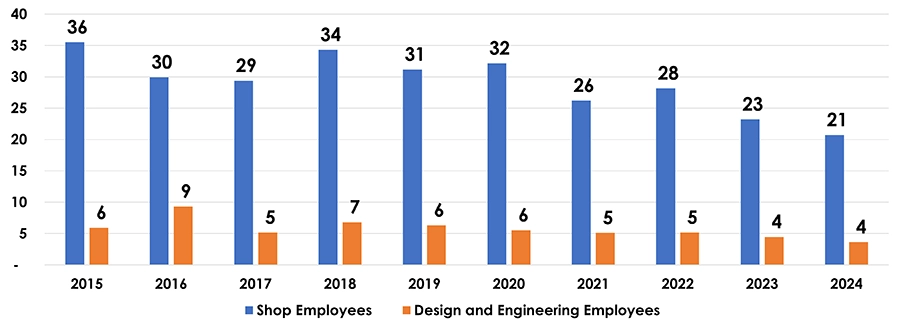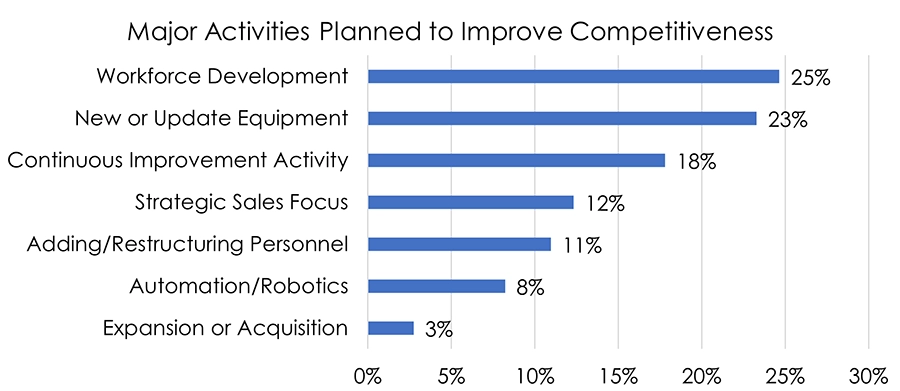By Rachael Pfenninger, director of strategic execution, AMBA
In 2015, US mold manufacturers were experiencing a revival of optimism. For instance, a whopping 60% of mold builders anticipated their business increasing substantially over the coming three months. The average number of shop hours hovered around 50, while design hours were around 47. Over three-quarters of companies reported difficulty in finding qualified employees, but less than 2% of reporting companies indicated that conditions were poor. In 2015, things weren’t looking too bad for the US mold manufacturing industry.
Today, some things are the same – it’s still fairly difficult to find employees, for example. But the rest of the landscape looks very different. According to recent data from AMBA’s 2024 Business Forecast Report, one major difference is that the average shop is much smaller. Where the average domestic mold builder employed a median of 36 shop employees and six design employees in 2015, today, that number is closer to 21 and four, respectively. Reported annual sales revenues also have fallen dramatically; where 72% reported annual sales revenues up to $14.9 million in 2015, 78% now report annual sales revenues under $10 million.
As the landscape shifts and shops shrink, it would be logical to conclude that the amount of business being conducted has been similarly impacted. However, a review of shop and design hours in 2024 indicates that conclusion isn’t necessarily correct. For example, although average shop employee count has fallen 42% since 2015, shop hours have fallen from 50 to 47 – a decrease of only 6%. Similarly, design hours also have fallen only slightly from 47 to 44, on average. How are mold builders getting it done – and what does it mean for the industry’s future? (See chart 1 below and chart 2 on page 40.)


To answer that question, it’s important to first review the challenges cited by the respondents of this year’s report. While a significant percentage of American mold manufacturers continue to cite workforce development as a top challenge, others have crept upwards in priority and now are nearly neck and neck with workforce needs.
For example, although a response from 18% of survey respondents kept workforce development in the top spot, this response percentage is nothing compared to years past. This allowed cost pressure and maintaining profitability to creep higher than ever before, as they were cited as challenges by 16% and 10% of respondents, respectively. Foreign competition, cash flow and new business development also represent top concerns of this year’s executive respondents.
To address these challenges, US mold manufacturers have shifted how they plan to be competitive in the coming months. Although workforce development, training and personnel adjustments all made the list of planned activities, the bulk of this year’s responses were focused on equipment, process improvement and business growth. Not only did over a quarter of this year’s respondents plan to purchase new equipment, update what they have or plan to expand their own business or acquire others; another 26% plan to focus on continuous improvement activities, automation implementation and/or robotics use (Chart 3).

Respondents didn’t only select the activities planned for 2024 – in many cases, they were able to shine a light on their reasoning through written comments. As one respondent wrote, “Keeping modern technology up-to-date helps us remain competitive, [so that we can] provide our services at the highest level of quality and speed possible.” Others wrote-in that they plan to improve throughput, implement new training procedures, streamline processes and more.
In reflection of these planned activities, a silver lining to these existing – and varied – challenges has emerged. As the industry’s workforce has dwindled, American mold manufacturers have had to rely more than ever on their resilience and innovation, which has led to more efficient operations industry-wide.
Certainly, it doesn’t seem that it will be an easy road ahead; but, perhaps optimism has just as much a place in the future as it’s had in the past.
AMBA’s 2024 Business Forecast Report now is available for purchase ($199 for members; $399 for non-members) at www.amba.org/publications. This report utilizes data from 33 economic indicator questions to showcase sales trends, profit levels, capital expenditures, shop and design employment levels and challenges, as well as 2023 performance, fourth-quarter performance and forecasts and expectations for 2024.


